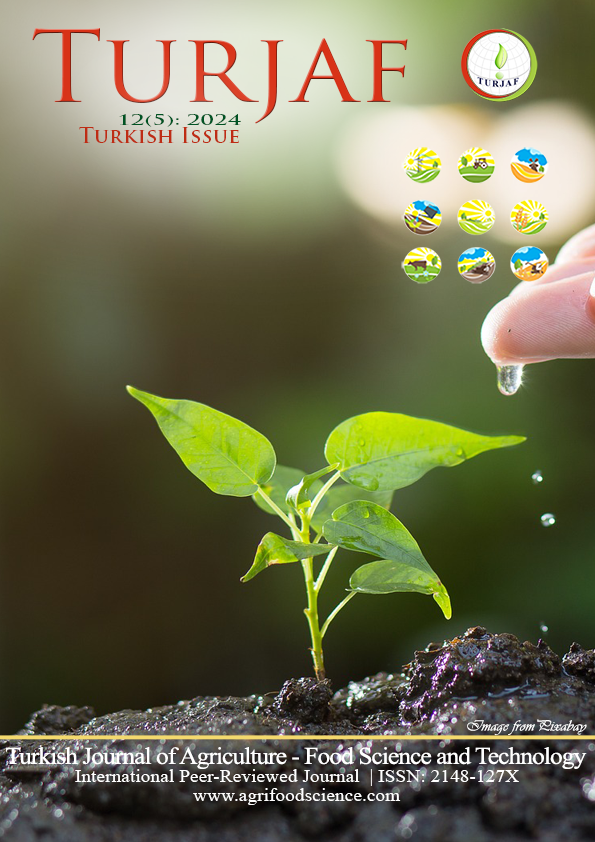The Effect of Salicylic Acid Application on Sunflower (Helianthus annus L.) Plant Development
DOI:
https://doi.org/10.24925/turjaf.v12i5.828-833.6467Keywords:
Sunflower, salicylic acid, plant growth, varietyAbstract
Salicylic acid, which is also considered a plant hormone, constitutes a group of phenolic substances and is a plant growth regulator that creates many metabolic and physiological reactions in plants and therefore affects plant growth and development. This study was conducted to determine the effects of salicylic acid application on the physiological and biochemical properties of sunflower varieties. It was established in climate chamber conditions with 3 replications, according to the Randomized Plot Trial Design. Three sunflower varieties, namely 11-TR-077, Deray and P-64-LC-108, and 5 doses of salicylic acid (control, 0.5, 1, 1.5 and 2 mM) were used as materials in the study. When the results were examined, it was observed that salicylic acid application had a positive effect on the Deray variety in terms of spad, plant height, number of leaves, root diameter, plant fresh weight and plant dry weight ratios.
References
Abreu, M.E., Munne-Bosch, S. (2009). Salicylic acid deficiency in NahG transgenic lines and sid2 mutants increases seed yield in the annual plant Arabidopsis thaliana. Journal of Experimental Botany, 60: 1261–1271.
Alverez, A.L. (2000). Salicylic acid in machinery of hypersensitive cell death and disease resistance. Plant Molecular Biology, 44: 429–442.
Amira, M.S., Qados, A. (2011). Effect of salt stress on plant growth and metabolism of bean plant Vicia faba (L.). Journal of Agricultural Sciences; 10: 7-15.of The Saudi Society
Arfan, M., Athar, H.B., Ashraf, M. (2007). Does exogenous application of salicylic acid through the rooting medium modulate growth an photosynthetic capacity in two differently adapted spring wheat cultivars under salt stress. Journal of Plant Physiology, 164: 685-694.
Arıoğlu, H.H., Kolsarıcı, Ö., Göksu, A.T., Güllüoğlu, L., Arslan, M., Çalışkan, S., Söğüt, T., Kurt, C., Arslanoğlu, F. (2010). Yağ bitkileri üretiminin artırılması olanakları. Türkiye Ziraat Müh. Bir. VII. Teknik Kong. Bildiri Kitabı I.: 361- 377. Ankara.
Aslantaş, R., (2013). Büyümeyi Düzenleyici Maddelerin Bahçe Bitkilerinde Kullanımı. Atatürk Üniv. Ziraat Fak. Bahçe Bitkileri Bölümü, Ders Notu. Erzurum.
Cameron, R.K. (2000). Salicylic acid and its role in plant defense responses: what do we really know? Physiological and Molecular Plant Pathology, 56: 91–93.
Culpan, E., Arslan, B. (2018). Salisilik asit uygulamasının aspir (Carthamus tinctorius L.) çeşitlerinin verim ve bazı kalite özelliklerine etkisinin araştırılması. Akademik Ziraat Dergisi 7(2):173-178.
Doğan, M., Tura, A., Odabaşıoğlu, C., Sedetaltun, Y., Odabaşıoğlu, M.İ. (2021). Salisilik Asitin Soya (Glycine max. (L.) Merr.) Tohumlarının Çimlenme ve Gelişimine Etkisi. Fırat Üniversitesi Fen Bil. Dergisi. 33(2), 115-124.
FAO 2023. https://www.fao.org/faostat/en/#data/QCL (Erişim tarihi 2023)
Güneri Bağcı, E. (2010). Nohut Çeşitlerinde Kuraklığa Bağlı Oksidatif Stresin Fizyolojik ve Biyokimyasal Parametrelerle Belirlenmesi. Doktora Tezi, Ankara Üniversitesi, Ankara, 2010.
Güneş, A., Inal, A., Bagci, E.G., Pilbeam, D.J. (2007). Silicon-mediated changes of some physiological and enzymatic parameters symptomatic for oxidative stress in spinach and tomato grown in sodic-B toxic soil. Plant and Soil, 290(1), 103-114.
Hayat, Q., Hayat, S., Irfan, M., Ahmad, A. (2010). Effect of exogenous salicylic acid under changing environment: A review. Environmental and Experimental Botany, 68: 14–25.
Kadakoğlu, B., Karlı, B. (2019). Türkiye’de yağlı tohum üretimi ve dış ticareti. Akademik Sosyal Araştırmalar Dergisi, Yıl: 7, Sayı: 96, Eylül 2019, s. 324-341.
Kalaycı, M. (2005). Örneklerle Jump kullanımı ve tarımsal araştırma için varyans analizi modelleri. Eskişehir Anadolu Tarımsal Araştırma Enstitüsü Yayınları, No:21, Eskişehir.
Kling, G.J., Meyer, M.M. Jr, (1983). Effects of Phenolic Compounds and Indoleacetic Acid on Adventitious Root Initiation in Cuttings of Phaseolus aureus, Acer saccharinum and Acer griseum. Hort. Science, 18 (3), 352-354.
Lee, S., Kim, S.G., Park, C.M. (2010). Salicylic acid promotes seed germination under high salinity by modulating antioxidant activity in Arabidopsis. New Phytologist, 188: 626–637.
Martinez, C., Pons, E., Prats, G., Leon, J. (2004). Salicylic acid regulates flowering time and links defence responses and reproductive development. The Plant Journal, 37: 209–217.
Martin-Mex, R., Villanueva-Couoh, E., Herrera-Campos, T., Larque-Saavedra, A. (2005). Positive effect of salicylates on the flowering of African violet. Scientica Horticulturae, 103: 499–502.
Mona, G.D., Mervat, S., Hozayen, M. (2012). Physiological Role of Salicylic Acid in Improving Performance, Yi-eld and Some Biochemical Aspects of Sunflower Plant Grown under Newly Reclaimed Sandy Soil. Australian Journal of Basic and Applied Sciences, 6 (4): 82-89.
Morris, K., MacKerness, S.A., Page, T., John, C.F., Murphy, A.M, Carr, J.P., Buchanan-Wollaston, V. (2000). Salicylic acid has a role in regulating gene expression during leaf senescence. The Plant Journal, 23: 677–685.
Rao, M.V., Davis, R.D. (1999). Ozone induced Cell Death Occurs Via Two Distinct Meachanisms İn Arabidopsis: The Role of Salicylic Acid. Plant J .,17,603-614
Shakirova, F.M., Sakhabutdinova, A.R., Bezrukova, M.V., Fatkhutdinova, R.A., Fatkhutdinova, D.R. (2003). Changes in the Hormonal Status of Wheat Seedlings Induced by Salicylic Acid and Salinity. Plant Scien-ce, 164: 317-322.
Shimakawa, A., Shiraya, T., Ishizuka, Y., Wada, K.C., Mitsui, T., Takeno, K. (2012). Salicylic acid is involved in the regulation of starvation stress-induced flowering in Lemna paucicostata. Journal of Plant Physiology, 169: 987–991.
Stevens, J., Senaratna, T., Sivasithamparam, K. (2006). Salicylic acid induces salinity tolerance in tomato (Lycopersicon esculentum cv. Roma): associated changes in gas exchange, water relations and membrane stabilization. Plant Growth Regulation, 49: 77–83.
Wada, K.C., Takeno, K. (2010). Stress-induced flowering. Plant Signaling and Behavior, 5: 1–4.
Wada, K.C., Yamada, M., Shiraya, T., Takeno, K. (2010). Salicylic acid and the flowering gene FLOWERING LOCUS T homolog are involved in poor-nutrition stress-induced flowering of Pharbitis nil. Journal of Plant Physiology, 167: 447–452.
Xie, Z., Zhang, Z.L., Hanzlik, S., Cook, E., Sjen, Q.J. (2007). Salicylic acid inhibits gibberellin-induced alpha-amylase expression and seed germination via a pathway involving an abscisic-acid-inducible WRKY gene. Plant Molecular Biology, 64: 293–303.
Yusuf, M., Hasan, S.A., Ali, B., Hayat, S., Fariduddin, Q., Ahmad, A. (2008). Effect of salicylic acid on salinity induced changes in Brassica juncea. Journal of Integrative Plant Biology, 50: 1096–1102.
Zengin, F.K. (2007). Fasulye fidelerinin (Phaseolus vulgaris L. cv. Strike) pigment içeriği üzerine bazı ağır metallerin etkileri. KSÜ Fen ve Mühendislik Dergisi 2007; 10(2): 164-172.
Downloads
Published
How to Cite
Issue
Section
License
This work is licensed under a Creative Commons Attribution-NonCommercial 4.0 International License.

























